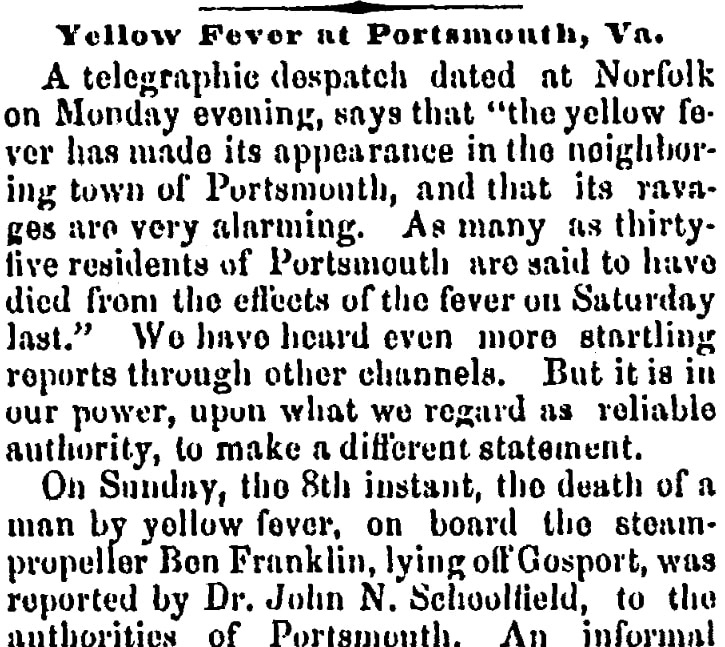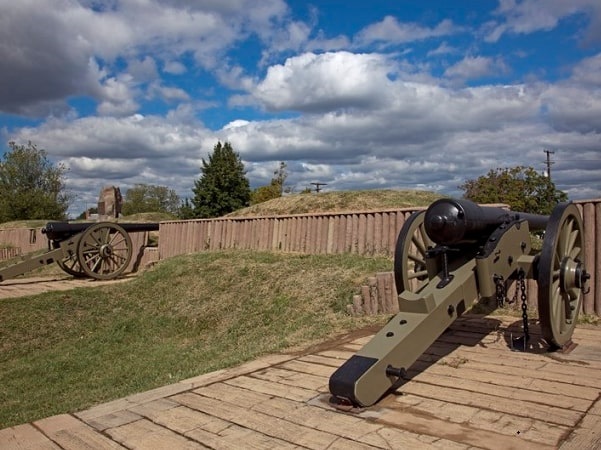Introduction: In this article, Melissa Davenport Berry continues her series on descendants of the Jamestown settlers, writing about the yellow fever epidemic of 1855. Melissa is a genealogist who has a blog, AnceStory Archives, and a Facebook group, New England Family Genealogy and History.
Today I continue with my “Jamestown Descendants: Who’s Who” series, with more focus on Lindsay-Lomax and allied family lines of Old Virginia who descend from Jamestown settlers.
To recap: My last three stories covered some of the narrative from the personal diary of Elizabeth Lindsay Lomax (1796-1875), entitled Leaves from an Old Washington Diary 1854-1863.
Today I focus on the yellow fever epidemic of 1855, one of the worst outbreaks in history, killing an estimated 3,000 people in Norfolk (approximately one-third of the city’s entire population), while upward of 1,000 died in Portsmouth.
In 1855 the Alexandria Gazette newspaper reported the disease was brought in by the steamer Benjamin Franklin, which docked in Hampton Roads for repairs after arriving from the West Indies. Some of the crew had died on board, while others who contracted the fever never returned before the ship was quarantined. As the newspaper noted, there were already fifteen cases reported in the area – and eight had perished.

In her diary, Mrs. Lomax wrote about friends and family members who either expired from the fever or were evacuating the area to survive.
Here is an entry mentioning her sister’s daughter Mattie and her offspring, who appear several times in later diary entries.
Tuesday, August 7, 1855.
It makes one’s heart ache to read of the ravages of the fever – We have lost so many dear friends.
Mattie Poor and her children arrived this morning from Norfolk on the steamer Water Witch. They are fleeing from the fever epidemic and will go to the Greenbrier White Sulphur Springs [West Virginia].
Mattie Lindsay Stark, daughter of Mattie Taliaferro Lindsay and Robert Bolling Stark (also spelled Starke), was a direct descendant of Jamestown’s William Tayloe, Henry Corbin, Hugh Gwyn, Ralph Wormeley, Thomas Lunsford, Richard Bolling, Thomas Cocke, Francis Mason, and John Stith.
She married Rear Admiral Charles Henry Poor (1808-1882), a true Yankee born to Moses Poor and Charlotte White. His family line can be traced back to the early Newbury, Massachusetts, settler families of Hale, Poor, West, Little, Hutchinson, Follansbee, Knight, Moody, and March.
Children born to Mattie and Charles:
- Richard Lowndes Poor married Sallie Magee Warwick
- Charles Henry Poor married Cornelia Tyler Longstreet
- Mattie Lyndsay Poor married Rear Admiral David Kindleberger
- Charlotte “Lottie” Lindsay Poor married Joseph Maxwell Wright
- Elizabeth Lindsay Poor married Theodore Frelinghuysen Jewell
- Annie Cunningham Poor married Charles Carroll Glover Sr.
Saturday, September 8, 1855.
Grieved to read in today’s paper of the death of Walter [Herron] Taylor [Sr.] of Norfolk.
All of Walter Herron Taylor Sr.’s children thankfully survived the outbreak including son Walter Herron Taylor, a descendant of Jamestown’s William Farrar, Richard Cocke, and Adam Thoroughgood.
He was assistant adjutant general to General Robert E. Lee, a key aide who rose to the rank of colonel. Read his book Four Years with General Lee.
Taylor was a banker, lawyer, soldier, politician, author, and railroad executive. He served as a senator in the Virginia General Assembly, and as an attorney for the Norfolk and Western Railway and later the Virginian Railway.
He married Elizabeth, aka “Miss Bettie” Selden Saunders, daughter of U. S. Navy Captain John Loyall Saunders and Martha Bland Selden (a descendant of Jamestown’s Saunders, Lightfoot, Armistead, Cary, Yeo, Taylor, Wilson, and Milner lines). The couple left many descendants.
One of Elizabeth Saunders’ siblings, Gen. John Selden Saunders, was Adjutant General of the Military Forces of the State of Maryland.
Also on Saturday, September 8, 1855, Mrs. Lomax noted that she left on a trip with her daughters:
Vic and Alice and myself went in an omnibus to the boat. On the way we took Mrs. Washington and her daughter. On the boat we found Mr. and Mrs. John Hipkins [wife Matilda A. Hutchings] and family running away from the fever in Norfolk, which is still raging.
You can read a full account of deaths and other reports from archivist Donna Bluemink.
Wednesday, July 19, 1856.
Sandy Stark spent the evening – poor fellow, he lost both his parents in the fever epidemic in Norfolk while he was at sea, which made it particularly hard on him.
Stark’s father Captain William Stark died on 18 August 1855, and his mother Elizabeth died on 31 August 1855. Sandy, born Alexander Wilson Stark (1839-1898), was an artillery expert whose instruction book was utilized throughout the Civil War. He served as lieutenant colonel in the Confederate Army, commanding an artillery brigade.
He was a friend of the above Col. Taylor, who wrote in a letter to his wife Miss Bettie:
Ma informs me that Sallie Tomkins intends taking Sandy Starke’s little sisters [orphaned from the yellow fever epidemic] to live with her.
Isn’t that like a good lady – I declare she is an angel on earth – or should I say she is a true woman. If everyone strived to do as she does how different matters would be. (Page 180, Lee’s Adjutant: The Wartime Letters of Colonel Walter Herron Taylor, 1862-1865.
Taylor is referring to Confederate nurse Sally Louisa Tompkins, aka “Captain Sally” or “Angel of the Confederacy.”
She was the daughter of Col. Christopher Tompkins and Mariah Booth Patterson. Sally lost her three sisters to an epidemic in 1842 which prompted her to do work in the humanitarian and health fields.
One of Stark’s sisters was Helen Stark, who married Col. Arthur Sinclair Cunningham, son of Commodore Robert Barron Cunningham and Annie Herron Stark, the daughter of the above Mattie Lindsay who married Robert Bolling Stark.
Stay tuned…
Explore over 330 years of newspapers and historical records in GenealogyBank. Discover your family story! Start a 7-Day Free Trial
Note on the header image: Civil War-era cannons, Fort Stevens, NW, Washington, D.C. Fort Stevens was part of the extensive fortifications built around the city during the American Civil War. Credit: The George F. Landegger Collection of District of Columbia Photographs in Carol M. Highsmith’s America; Library of Congress, Prints and Photographs Division.
Related Articles:
